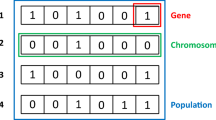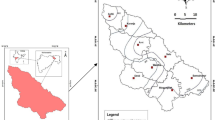Abstract
Contamination of groundwater poses serious threat to the human health and environment. It is difficult and expensive to clean up contaminated aquifers. Identification of unknown pollution sources is vital for adopting any remediation strategy. Groundwater flow and transport simulation model is used to generate necessary data for Artificial Neural Networks (ANN) model building processes. Breakthrough curves obtained for specified pollution scenario are characterized to reduce the inputs to ANN model. The characterized breakthrough curves parameters serve as inputs to ANN model. Unknown pollution source characteristics, flow parameters and transport parameters are outputs for ANN model. Identification of sources is performed with considerations of three cases—simultaneous estimation of unknown sources and flow parameter; simultaneous estimation of unknown sources, flow and transport parameters; and simultaneous estimation of unknown sources and boundary head. Characterization of uncertainty in source identification due to uncertainty in flow parameter, uncertainty in transport parameter and uncertainty in constant head boundary estimation is performed using fuzzy vertex alpha-cut techniques.











Similar content being viewed by others
References
Ajmera TK, Rastogi AK (2008) Artificial neural network application on estimation of aquifer transmissivity. J Spat Hydrol 8(2):15–31
Aly AA, Peralta RC (1999) Optimal design of aquifer cleanup systems under uncertainty using a neural network and a genetic algorithm. Water Resour Res 35(8):2523–2532
Aral MM, Guan J, Maslia ML (2001) Identification of contaminant source location and release history in aquifers. J Hydrol Eng 6:225–234
Aziz ARA, Wong KV (1992) A neural network approach to the determination of aquifer parameter. Ground Water 30(2):164–166
Balkhair KS (2002) Aquifer parameter determination for large diameter wells using neural network approach. J Hydrol 265:118–128
Bear J (1972) Dynamics of Fluids in Porous Media. Dover Publication Inc., New York
Bear J (1979) Hydraulics of Groundwater. Elsevier, New York
Bishop CM (1995) Neural Networks For Pattern Recognition. Oxford University Press, India
Bredehoeft JD, Pinder GF (1973) Mass transport in flowing water. Water Resour Res 9:194–210
Freeze RA, Cherry JA (1979) Groundwater. Prentice-Hall, Inc.: N. J.
Garcia LA, Shigidi A (2006) Using neural networks for parameter estimation in groundwater. J Hydrol 318(1–4):215–231
Jha M, Datta B (2014) Linked simulation-optimization based dedicated monitoring network design for unknown pollutant source identification using dynamic time warping distance. Water Resour Manag 28:4161–4182
Karahan H, Ayvaz MT (2008) Simultaneous parameter identification of a heterogeneous aquifer system using artificial neural networks. Hydrogeol J 16:817–827
Keidser A, Rosbjerg D (1991) A comparison of four inverse approaches to groundwater flow and transport parameter identification. Water Resour Res 27(9):2219–2232
Konikow LF, Bredehoeft JD (1978) Computer model of two-dimensional solute transport and dispersion in groundwater. US Geol Surv Tech Water Resour Invest Book 7
Lingireddy S (1998) Aquifer parameter estimation using genetic algorithms and neural networks. Civ Eng Environ Syst 15:125–144
Maier HR, Dandy GC (2000) Neural networks for the prediction and forecasting of water resources variables: a review of modeling issues and applications. Environ Model Softw 15:101–124
McLaughlin D, Townley LR (1996) A reassessment of the groundwater inverse problem. Water Resour Res 32(5):1131–1161
Morshed J, Kaluarachchi JJ (1998) Parameter estimation using artificial neural network and genetic algorithm for free product and recovery. Water Resour Res 34(5):1101–1113
Pinder GF, Bredehoeft JD (1968) Application of the digital computer for aquifer evaluations. Water Resour Res 4:1069–1093
Ranjithan S, Eheart JW, Rarret JH (1993) Neural network-screening for groundwater reclamation under uncertainty. Water Resour Res 29(3):563–574
Rogers LL, Dowla FU (1994) Optimization of groundwater remediation using artificial neural networks with parallel solute transport modeling. Water Resour Res 30(2):457–481
Rogers LL, Dowla FU, Johnson VM (1995) Optimal field scale groundwater remediation using artificial neural network and genetic algorithm. Env Sci Technol 29(5):1145–1155
Seng KY, Nestorov I, Vicini P (2007) Simulating pharmacokinetic and pharmacodynamic fuzzy-parameterized models:a comparison of numerical methods. J Pharmacokinet Pharmacodyn 34:595–621
Shigidi A, Garcia LA (2003) Parameter estimation in groundwater hydrology using artificial neural networks. J Comput Civil Eng 17(4):281–289
Singh RM, Datta B (2007) Artificial neural network modeling for identification of unknown pollution sources in groundwater with partially missing concentration observation data. Water Res Manag 21(3):557–572
Singh RM, Datta B, Jain A (2004) Identification of unknown groundwater pollution sources using artificial neural networks. J Water Res PL Asce 130:506–514
Srivastava D, Singh RM (2014) Breakthrough curves characterization and identification of an unknown pollution source in groundwater system using an artificial neural network (ANN). Environ Forensic 15(2):175–189
Task Committee ASCE (2000) Artificial neural networks in Hydrology I: Preliminary concepts. J Hydrol Eng 5(2):115–123
Zio E (1997) Approaching the inverse problem of parameter estimation in groundwater models by means of artificial neural networks. Prog Nucl Energ 31(3):303–315
Author information
Authors and Affiliations
Corresponding author
Rights and permissions
About this article
Cite this article
Srivastava, D., Singh, R.M. Groundwater System Modeling for Simultaneous Identification of Pollution Sources and Parameters with Uncertainty Characterization. Water Resour Manage 29, 4607–4627 (2015). https://doi.org/10.1007/s11269-015-1078-8
Received:
Accepted:
Published:
Issue Date:
DOI: https://doi.org/10.1007/s11269-015-1078-8




